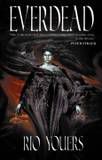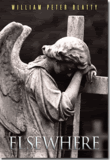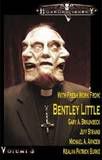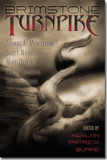Everdead / Rio Youers
 Graveside Tales / October 2008
Graveside Tales / October 2008
Reviewed by: Derek Clendening
Tobey Matthews needs a vacation. Like many unattached young men, he joins two friends for a getaway to picturesque San Antonio on the promise of fun, debauchery, and sex. Danger isn’t on the list, however — not for Tobey Matthews. Forgetting about his calloused ex-girlfriend seems like tall enough an order without having to muster the courage to ask out Cass, the young babe he meets at the bar. Not long after he wins Cass’ favor, the group finds that Cass’ friend Sheri has been abducted by a creature none of them wants to believe really exists. At least not as far as Tobey is concerned. Still, he knows that he must check his cynicism at the door because this creature will travel the world to find him if he must. In Everdead, vampires have resurfaced yet again, but the real draw to Youers’ novel has nothing to do with Luca, the Italian vampire.
Reviews and book blurbs routinely compare authors to Stephen King, but Youers genuinely warrants the comparison. Here’s why: his study of the least interesting of human subjects makes this novel captivating. Youers clearly has the skills and sensibility necessary to create a highly fascinating and sympathetic protagonist. Even when King carries on for pages and you find yourself wondering What the hell is he getting at?, you’re still hooked. That’s what Youers has done in Everdead. Tobey Matthews is no hunky stud with a trendy five o’clock shadow and a stake and hammer. In fact, he’s a total loser. He’s a character with a history and problems that most of us can relate to somehow. That he ‘gets the girl’ isn’t as much of a triumph as his rising above his normal limitations. In this sense, Youers brings the character and plot arc to satisfying fruition better than most. Even when Youers fails to convince as strongly with the secondary character of Tobey’s friend Johnny – the success story who takes his life and flushes it down the toilet through overindulgence in marijuana – the reader will be apt to forgive the misstep. On the other hand, it’s all still a bit more refreshing than using the tired alcoholic archetype that horror fiction has seen too much of.
Concerning the actual vampirism depicted in the book itself, Youers uses his share of clichés — most notably young folks conversing in a tongue-in-cheek manner and fighting off vampires with garlic, both contrivances reminiscent of Fright Night. If you want something innovative in terms of vampire lore, you might need to search a little farther.
Aside from the exceptional characterizations, Everdead is ripe with beautiful language. Readers generally don’t find such poetic works from authors who haven’t yet hit the mainstream, but it might be okay to believe that Youers is an exception to the rule. Hands down, Everdead is the best book this reviewer has read all year, and readers aren’t likely to put this one down either.
Purchase Everdead by Rio Youers.
Elsewhere / William Peter Blatty
 Cemetery Dance / Forthcoming 2009
Cemetery Dance / Forthcoming 2009
Reviewed by: Blu Gilliand
Echoes of Shirley Jackson’s seminal classic The Haunting of Hill House can be heard throughout Elsewhere, a short William Peter Blatty novel that was originally published in the anthology 999 and appears now for the first time as a standalone edition from Cemetery Dance. There’s an isolated house with a past veiled in tragedy, a group of four individuals – believers and non-believers alike – coming together to investigate the house, and plenty of strange noises in the night. In the beginning, the similarities are enough to give Blatty’s novel the feel of a remake, that hottest of Hollywood horror trends. But soon enough events begin to take different turns, and while we do tread in some familiar territory, there’s definitely no need for Shirley Jackson’s estate to begin sharpening their knives.
Ambitious real estate agent Joan Freeboard is offered triple commission if she can somehow sell Elsewhere, an abandoned island mansion near Manhattan. To pave the way for a sale, she decides to first debunk the house’s haunted reputation. She enlists her close friend, Pulitzer Prize-winning author Terence Dare, to spend a few days in the mansion documenting the investigations of psychic Anna Trawley and NYU researcher Dr. Gabriel Case. And, just to ensure the high visibility of the investigation, she sleeps with a Vanity Fair editor in exchange for publication of Dare’s article.
The group takes a ferry to Elsewhere, arriving in the midst of a driving rainstorm that never really lets up. The rain is just the first trick Blatty uses to cultivate Elsewhere’s oppressive atmosphere, adding a television that shows only static and phone calls that never seem to connect for good measure. It’s not long before odd booming sounds begin to echo up and down the mansion’s halls and fleeting glimpses of ethereal strangers are caught around corners.
None of these incidents are new to anyone who’s heard or read a haunted house story, but Blatty uses them expertly to slowly tighten the screws on the secluded group — as well as the reader. We quickly begin to form a picture of what might be happening, yet Blatty’s skillful misdirection keeps us guessing. Without giving away the final revelation, it’s fair to acknowledge that it’s one readers have seen before. Yet – to Blatty’s credit – this reader was never able to decide for sure that this was the ending he was going to get. Elsewhere is built on a familiar premise and a somewhat predictable outcome, and yet it still manages to keep you questioning things up to the end.
This is a short, fast-paced novel, but Blatty takes time to flesh out the characters enough to keep readers invested in their fate. While not in the same league of The Haunting of Hill House or The Shining, it’s a good, solid haunted house tale. If you missed it in 999, it would be worth your while to pick it up.
Pre-order Elsewhere by William Peter Blatty.
Horror Library: Volume 3 / Edited by R.J. Cavender
 Cutting Block Press / October 2008
Cutting Block Press / October 2008
Reviewed by: Martel Sardina
If you’re not sure what to get the horror lovers on your Christmas list this year, Horror Library: Volume 3 would be a welcome addition to most fans’ collections.
This reviewer was not sure what to expect from this anthology, having not read previous volumes. But with names like Bentley Little, Gary Braunbeck and John Everson gracing the table of contents, how could a reader go wrong? It wasn’t until this reader flipped to a story called “After” that she initially suspected the editors had.
Kealan Patrick Burke’s “After” is a story about a school shooter, a topic that this reviewer found fascinating when she discovered Richard Bachman’s “Rage” — but one that had lost its appeal as fiction became reality in schools across the country in recent years. It was hard to want to read this story. With all the media scrutiny on the various real-life cases, how could Burke spin the subject matter to add something new? Happily, Burke does just that, leaving the reader with an emotionally satisfying payoff at the end.
Frustrated by airport security procedures put in place in the wake of 9/11? Michael Arzen’s “Guarded” explains why you have more to fear when you don’t pass the initial screening process.
Have you ever wondered what drives people to starve themselves? In “The Living World,” C. Michael Cook explores the motivating force behind one woman’s eating disorder, and caused this reviewer to suffer a loss of appetite herself. The scariest thing about this story was the realization that the patient’s logic is true.
City dwellers avoid small town living for fear of a lackluster nightlife. In John Everson’s “Fish Bait,” two friends find out what they’ve been missing when a stop for food and camping supplies in a Podunk town goes horribly wrong.
The funniest story in the anthology is Jeff Strand’s “The Apocalypse Ain’t So Bad.” Strand’s protagonist is an optimist who can’t understand why the people left in his post-apocalyptic world aren’t thankful to have survived. Yes, there are mutants. But the lines at Disney World are now shorter. And thanks to the untimely demise of most of the world’s population, Barnes & Noble has now become his own personal library. What’s not to love? Even the dreaded mutant bite can’t get him down.
It’s not often that a book reviewer is the protagonist in a horror tale, though it stands to reason why an author might want to subject a book reviewer to torment and woe. Rick Moore’s “The Review” was the most enjoyable story to this reviewer on a personal level. Moore caused me to reassess why I chose to review books in the first place. Unlike Wilton, Moore’s renowned book critic, my intent was not to pontificate, but to learn something about the craft of writing by reading and analyzing other writers’ works and see if I could apply that knowledge to make my own writing better. It’s not known to the reader whether Wilton ever held that same intent, but it is clear that over the span of his career the joy he once derived from reading books has waned. And perhaps now, he only derives joy from the failure of others. The receipt of a strange book called “The Review” causes Wilton to take a hard look back at his own failures and to remember all that he’d hoped to forget.
If the quality of the stories selected for Horror Library: Volume 3 is any indication of what to expect from the series on the whole, readers may want to add the previous volumes to their Christmas wish lists as well.
Purchase Horror Library: Volume 3, edited by R.J. Cavender.
The Reach / Nate Kenyon
 Leisure / November 2008
Leisure / November 2008
Reviewed by: Martel Sardina
It’s not often that a Professor comes to a student for help. Jess Chambers, a grad student majoring in Psychology, is honored by the opportunity Professor Jean Shelley has offered her. It’s a chance to get some hands-on training in a complex case. And depending on whether or not Chamber’s agrees with the current diagnosis, it could mean a different life for the patient, Sarah, a ten-year-old girl.
Upon arriving at the Wasserman Children’s Psychiatric Facility, Jess is shocked to learn that Sarah has been heavily sedated and isolated from the other patients for much of the time she has been in Dr. Wasserman’s care. While Dr. Wasserman insists that his prescribed practices are necessary not only for Sarah’s safety, but also for the safety of the staff and other patients, Jess is skeptical. How much damage can one young girl possibly cause?
Jess grows increasingly frustrated with Professor Shelley and Dr. Wasserman when she discovers that significant chunks of information have been removed from Sarah’s files. How is she supposed to assess the girl’s condition without a proper medical history? Shelley and Wasserman are coy, stating they don’t want to taint Jess’s view of the case. They’re withholding information in order to help Jess give them an unbiased opinion.
As Jess gets to know Sarah better, she begins to disbelieve Wasserman’s theory that the girl is dangerous. During a visit, Jess decides to remove the girl’s restraints to try and build trust, to prove to Sarah that she isn’t just another one of ‘them.’ Jess soon finds out that Wasserman was right. Bearing witness to Sarah’s unbelievable power sends Jess on a mission to learn all she can about the girl’s family and the circumstances that led to her being placed under Wasserman’s care.
At this point, Nate Kenyon shifts his paranormal thriller into high gear sending Jess in search of the truth in order to save Sarah’s life.
The Reach is rich with detail about life in Boston and its surrounding suburbs. Kenyon’s descriptions of the architecture and the colorful neighborhoods bring the setting to life. Many times setting is not integral to plot, but in this case, Kenyon makes it clear that this story couldn’t have happened anywhere else.
Legal and medical thrillers can be so steeped in the technical details that the reader often finds himself lost in pages of exposition wondering if the author is writing a research paper or a work of fiction. Kenyon’s writing style is conversational and provides readers with the right amount of technical jargon and explanation, revealing details without hindering the story’s pacing.
The Reach is Nate Kenyon’s second novel. Unfamiliar with his first book, this reviewer was so impressed with his sophomore effort that she will be adding Bloodstone to her Christmas wish-list. Here’s hoping that Santa will bring both books to readers everywhere this year.
Purchase Nate Kenyon’s The Reach.
HAWG / Steven Shrewsbury
 Graveside Tales / August 2008
Graveside Tales / August 2008
Reviewed by: Martel Sardina
Drug mules. Addicts. Gun-toting bikers. An old farmer preparing ye for the way of the Lord. A father who is just trying to keep his family safe. And a cop who is trying to figure out what kind of hell has been unleashed on Miller’s Fork, a rural central Illinois town. If action-packed horror is what ye seek, then look no further than Steven Shrewsbury’s HAWG.
HAWG has all the elements of a good action/horror adventure. The story opens on Mr. Solow’s farm. Solow is in the process of castrating piglets when a drug runner’s botched robbery attempt goes horribly wrong. Solow’s assailants are turned over to the pig-man monster, the one Solow calls Hawg.
After enjoying the victor’s spoils, Hawg escapes the Solow farm. The people of Miller’s Fork think strange events – like the death of the Ellington family’s pit bull – are a nuisance caused by a roving pack of wolves. It’s not until youngsters Jordan White and Cassidy Ellington escape from the titular creature by hiding in an abandoned mineshaft that the grown-ups start believing that the threat is real.
Jordan’s father, Andrew, joins forces with his brother, Doug, the town’s sheriff to bring peace back to this quiet country town. They also receive help from unlikely sources — such as Hux, a biker who barely survived his own run-in with the beast.
While the story is entertaining overall, savvy genre readers may be reminded of another action-packed adventure — Mad Dogs by Brian Hodge. In Mad Dogs, the reader knows immediately that Jamey Shepard is Hodge’s protagonist. While Hodge also used multiple viewpoints to tell his tale, he never lost sight of whose story he was telling. The transitions from one viewpoint to another were seamless and each of the viewpoint characters had their own distinct story arc that Hodge successfully brought to completion.
In Shrewsbury’s HAWG, this reviewer noticed that while it was easy to get caught up in the plot and the action as it unfolded, there was a disconnect from the characters at various stages throughout — perhaps attributable to the author’s execution of the multiple viewpoints. The protagonist is not immediately evident, leaving the reader to wonder whom they should be rooting for.
Another point of contention: the author’s use of rape as a plot device. If an author is going to put a character through something as traumatic as rape, the author owes it to the reader to portray that event with sincerity. Make it brutal and real to the reader. While the author need not describe the rape itself in graphic detail, the event itself should come off as real and should do justice to the emotions that such a brutal event would cause. In this case, the portrayal of rape that occurs after the initial incident in the prologue leans toward the gratuitous versus being an integral component of the plot.
That said, HAWG introduces us not only to the pig-man but many other human monsters. Shrewsbury leaves open the possibility of a return to Miller’s Fork and if he decides to take readers back there, this reviewer hopes we’ll see more of them – particularly Mr. Solow – next time around.
Purchase Steven Shrewsbury’s HAWG.
The Chosen / C.A. Milson
 Amira Press / July 2008
Amira Press / July 2008
Reviewed by: Michele Lee
Alex Manning is a nice guy with impressive psychic powers. At the outset of The Chosen, he’s suffering the effects of a horrible haunting, or possibly just anxiety attacks that cause visions. Serendipitously drawn to a group of paranormal investigators, Alex forces his way into their most dangerous case yet, a re-investigation of the Jamiesonn house. Trapped within is the colonial era spirit of a cult leader who nearly slaughtered a town and who is looking for a new body to finish his evil deeds.
While each character, their past and their motivations are explained to the captive reader, this book comes off as stodgy and trite. Being told the drive of the characters doesn't help readers form a picture of them, particularly when descriptions of the characters and setting are often missing. What readers are shown is flat and stereotyped, to the point where characters even refer to each other by bland generalities such as "Mr. All-American" and "the Native American".
The plot itself struggles to gain ground, in part because the reader is informed of a great number of things and shown next to nothing. The prose fails to reach any semblance of cadence, cutting off any sense of tension before it builds. Evil demons, ghosts and sorcerers fail to invoke real fear and the spanning plot of one man chosen for greatness and imbued with amazing powers to fight the coming dark lord seems tired when nothing new is offered.
Purchase The Chosen by C.A. Milson.
Brimstone Turnpike / Edited by Kealan Patrick Burke
 Cemetery Dance / September 2008
Cemetery Dance / September 2008
Reviewed by: Blu Gilliand
Brimstone Turnpike is the newest editorial effort by Kealan Patrick Burke, an author who continues to carve out his own solid niche in the horror/supernatural genre. For his latest project he has assembled a talented lineup of writers (Thomas F. Monteleone, Scott Nicholson, Mike Oliveri, Harry Shannon, and Tim Waggoner), each of whom delivers a solid tale with one constant thread — a character of Burke’s creation named Johnny Divine.
Divine holds court outside an abandoned gas station on the titular Turnpike, a road that seems to be located everywhere and nowhere. The characters who find their way to this road are all on some kind of journey, and getting to Point B from Point A is only a part of it. The quarrelling couple in Oliveri’s “Warning Signs” is traveling the road to reconciliation; Shannon’s maverick cop is looking for redemption in “Behold the Child;” Monteleone’s journalist seeks truth in “The Prime Time of Spenser Golding.” The characters don’t always know what it is they’re looking for, but Divine does, and he always has something in his battered old case to help them along the way.
The tales presented here are good stories; nothing flashy or groundbreaking, just interesting characters doing interesting things. Nicholson’s contribution “Burial to Follow” stands out in particular with its dead-on examination of the oft-strange rituals that accompany funerals in the South. Waggoner’S “A Strange and Savage Garden” is another favorite; although it bogs down a bit in heavy exposition near the end, it remains a fascinating and enjoyable look at reality through the eyes of those who can bend it to their will.
If there is a weak spot in the collection it comes in the thread that is there to hold it all together: Johnny Divine. Although the mysterious man and his mysterious gifts play an integral role in each story, we don’t know anything about Divine himself by the end of the book. His motivations and character remain as murky as the man’s silver-hued eyes, and even the framing pieces written by Burke do little to illuminate him. Perhaps that’s the point; perhaps he’s meant to remain as much an enigma to us as he is to the characters in these stories. But I can’t help but feel that exploring the character a bit more would have made the collection a stronger, more unified work.
As it stands, Brimstone Turnpike works well as a collection of works by some very talented authors. Burke should be commended for pulling together another stellar lineup and giving them the freedom to run in all directions with his concept. Although a more cohesive collection would have been welcomed, this is still a highly worthwhile read.
Purchase Brimstone Turnpike edited by Kealan Patrick Burke.




